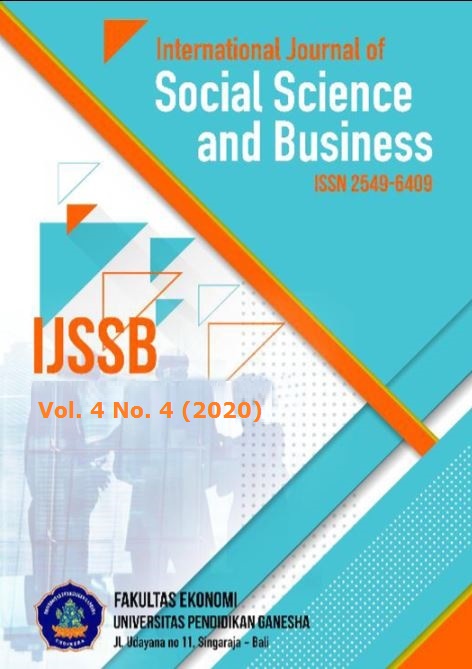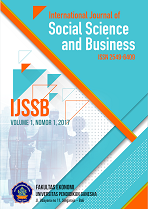An Implication of Destination Attractiveness, Environmental Sensitivity, and Satisfaction with Interpretive Service on Place Attachment and Environmental Responsible Behavior
DOI:
https://doi.org/10.23887/ijssb.v4i4.29017Kata Kunci:
Destination Attractiveness, Environmental Sensitivity, Place Attachment, Satisfaction with Interpretive Service, Environmental Responsible BehaviourAbstrak
This study examines the effect of destination attractiveness, environmental sensitivity, and satisfaction with interpretive services on place attachment. This study also aims to identify the effect of place attachment on environmentally responsible behavior. This study was using a questionnaire as a data collection method. This study's total sample was 400 respondents. However, the number of questionnaires that can be processed as 398. The data were processed using PLS-SEM (Partial Least Square). The result was obtained in this study: destination attractiveness has a significant positive effect on place attachment; environmental sensitivity has a significant positive effect on place attachment; satisfaction with interpretive services has a significant positive effect on place attachment; place attachment has a significant positive effect on environmentally responsible behavior; destination attractiveness has a significant positive effect on environmentally responsible behavior; environmental sensitivity has a significant positive effect on environmentally responsible behavior; satisfaction with interpretive services has a significant positive effect on environmentally responsible behavior. This research contributes to the literature on tourism marketing.
Referensi
Ballantyne, R., Packer, J., & Falk, J. (2011). Visitors’ learning for environmental sustainability: Testing short-and long-term impacts of wildlife tourism experiences using structural equation modelling. Tourism Management, 32(6), 1243–1252. https://doi.org/10.1016/j.tourman.2010.11.003
Bamberg, S., & Möser, G. (2007). Twenty years after Hines, Hungerford, and Tomera: A new meta-analysis of psycho-social determinants of pro-environmental behaviour. Journal of Enviromental Psychology, 27(1), 14–25. https://doi.org/10.1016/j.jenvp.2006.12.002
Barnett, M., Lord, C., Strauss, E., Rosca, C., Langford, H., Chavez, D., & Deni, L. J. T. J. o. E. E. (2006). Using the urban environment to engage youths in urban ecology field studies. The Journal of Environmental Education, 37(2), 3–11. https://doi.org/10.3200/JOEE.37.2.3-11
Chawla, L. (1998). Significant life experiences revisited: A review of research on sources of environmental sensitivity. The Journal of Environmental Education, 29(3), 11–21. https://doi.org/10.1080/0095896980959911410.1080/00958969809599114
Cheng, T., C. Wu, H., & Huang, L. (2013). The influence of place attachment on the relationship between destination attractiveness and environmentally responsible behaviour for island tourism in Penghu, Taiwan. Journal of Sustainable Tourism, 21(8), 1166–1187. https://doi.org/10.1080/09669582.2012.750329
Cheng, T., & Wu, H. (2015). How do environmental knowledge, environmental sensitivity, and place attachment affect environmentally responsible behaviour? An integrated approach for sustainable island tourism. Journal of Sustainable Tourism, 23(4), 557–576. https://doi.org/10.1080/09669582.2014.965177
Chiu, Y. H., Lee, W., & Chen, T. (2014). Environmentally responsible behaviour in ecotourism: Antecedents and implications. Tourism Management, 40, 321–329. https://doi.org/10.1016/j.tourman.2013.06.013
Dolnicar, S., & Leisch, F. (2008). An investigation of tourists’ patterns of obligation to protect the environment. Journal of Travel Research, 46(4), 381–391. https://doi.org/10.1177/0047287507308330
Halpenny, E. A. (2006). Environmental Behaviour, Place Attachment and Park Visitation: A case study of visitors to Point Pelee National Park. UWSpace. http://hdl.handle.net/10012/718
Ham, S. H., & Weiler, B. (2007). Isolating the Role of On-site Interpretation in a Satisfying Experience. Journal of Interpretation Research, 12(2), 5–24.
Hou, J., Lin, C., & Morais, D. (2005). Antecedents of attachment to a cultural tourism destination: The case of Hakka and non-Hakka Taiwanese visitors to Pei-Pu, Taiwan. Journal of Travel Research, 44(2), 221–233. https://doi.org/10.1177/0047287505278988
Hu, Y., & Ritchie, J. (1993). Measuring destination attractiveness: A contextual approach. Journal of Travel Research, 32(2), 25–34. https://doi.org/10.1177/004728759303200204
Hungerford, H. R., & Volk, T. L. (1990). Changing learner behaviour through environmental education. The Journal of Environmental Education, 21(3), 8–21. https://doi.org/10.1080/00958964.1990.10753743
Moore, R. L., & Graefe, A. R. (1994). Attachments to recreation settings: The case of rail‐trail users. Leisure Sciences, 16(1), 17–31. https://doi.org/10.1080/01490409409513214
Prayag, G., Suntikul, W., & Agyeiwaah, E. (2018). Domestic tourists to Elmina Castle, Ghana: motivation, tourism impacts, place attachment, and satisfaction. Journal of Sustainable Tourism, 26(12), 2053–2070. https://doi.org/10.1080/09669582.2018.1529769
Ramkissoon, H., Weiler, B., & Smith, L. (2012). Place attachment and pro-environmental behaviour in national parks: The development of a conceptual framework. Journal of Sustainable Tourism, 20(2), 257–276. https://doi.org/10.1080/09669582.2011.602194
Scannell, L., & Gifford, R. (2010). The relations between natural and civic place attachment and pro-environmental behavior. Journal of Environmental Psychology, 30(3), 289–297. https://doi.org/10.1016/j.jenvp.2010.01.010
Stegneiko, A.S., Tikhotskaya, I.S., Kato, S. (2018). The Role Of The Images Of Japan And Its Prefectures In The Attractiveness Of Japan As A Tourist Destination. Geography, Environment, Sustainability, 11(2), 5-16. https://doi.org/10.24057/2071-9388-2018-11-2-5-16
Tsang, N. K., Yeung, S., & Cheung, C. (2011). A critical investigation of the use and effectiveness of interpretive services. Asia Pacific Journal of Tourism Research, 16(2), 123–137. https://doi.org/10.1080/10941665.2011.556336
Williams, D. R., & Vaske, J. (2003). The measurement of place attachment: Validity and generalizability of a psychometric approach. Forest Science, 49(6), 830–840. https://doi.org/10.1093/forestscience/49.6.830
Zhao, M., Dong, S., Wu, H. C., Li, Y., S., T., Xia, B., Zheng, J., & Guo, X. (2018). Key impact factors of visitors’ environmentally responsible behaviour: Personality traits or interpretive services? A case study of Beijing’s Yuyuantan Urban Park, China. Asia Pacific Journal of Tourism Research, 23(8), 792–805. https://doi.org/10.1080/10941665.2018.1493518
Zhao, S. N., & Timothy, D. (2017). Tourists’ consumption and perceptions of red heritage. Annals of Tourism Research, 63, 97–111. https://doi.org/10.1016/j.annals.2017.01.003











